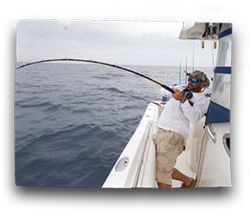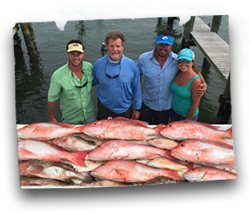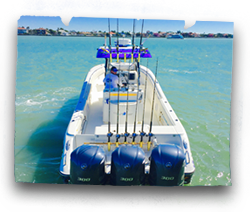Florida Fish Identification
Greater Amberjack
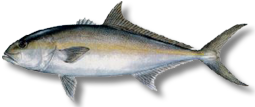 Description: Silver and black skin separated by a distinguishable yellowish stripe down the mid-section of body. Amberjack have a dark stripe from their nose to the front of dorsal fin which"lights up" when they are in feeding mode.
Description: Silver and black skin separated by a distinguishable yellowish stripe down the mid-section of body. Amberjack have a dark stripe from their nose to the front of dorsal fin which"lights up" when they are in feeding mode.
Where Found: Offshore around rocky reefs, debris, and wrecks, typically in 60 - 240 feet of water; juveniles associated with floating objects and may occur in water less than 30 feet deep.
Feeding Habits: Feeds best on live bait (pinfish, cigar minnows, croakers, Grunts, spadefish and squirrelfish). Also feeds on dead bait (spanish sardines, threadfin and finger mullet) squid, and crustaceans.
Size Range: From 20-100 lbs. Current Florida state record 142 lbs.
Food Value: Good table fare if cooked properly. Thick white fillets, with a medium to strong fish taste. Served in restaurants as a main dish, or used as key ingredient in fish spread.
Great Barracuda
 Description: Fierce and furious looking fish. Elongated lower jaw display it’s rows of large razor sharp teeth. Bluish backs, with silver sides. Distinguishing black spots randomly scattered on lower body. A fierce fighting fish when hooked, offering frantic runs all around the boat.
Description: Fierce and furious looking fish. Elongated lower jaw display it’s rows of large razor sharp teeth. Bluish backs, with silver sides. Distinguishing black spots randomly scattered on lower body. A fierce fighting fish when hooked, offering frantic runs all around the boat.
Where Found: Found in large numbers offshore and inshore along the Florida coast and Keys, the Bahamas, Central and South America. Found near reefs, wrecks, hard bottom, mud flats or inshore estuaries.
Feeding Habits: A top-level, high speed, aggressive predator, barracuda feed on a wide variety of fish. They favor fish with silvery or shiny characteristics. Eat Sardines, herring, snapper, groupers, jacks, tuna, and more.
Size Range: From 5-35 lbs.
Food Value: None. Not recommended for human consumption.
Blackfin Tuna
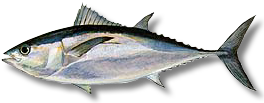 Description: Blackfin tuna are the most abundant tuna species. They are equally shaped from the head and tail from their midsection, making look in shape like a football. Silver side, dark blue on the back and white on the stomach. Small gray finlets run from the second dorsal fin to the anal fin. Eyes are large size.
Description: Blackfin tuna are the most abundant tuna species. They are equally shaped from the head and tail from their midsection, making look in shape like a football. Silver side, dark blue on the back and white on the stomach. Small gray finlets run from the second dorsal fin to the anal fin. Eyes are large size.
Where Found: Found offshore in warmer water during summer months, on or near the surface usually near offshore reefs, along current lines over reefs and banks . Prefers water above 67 F.
Feeding Habits: Feeds in schools by surrounding prey or "corraling up" bait schools. Also feeds on small crustaceans, squid and small food organisms in the water through straining.
Size Range: From 10-35 lbs. Current Florida state record 45 lbs. 9 oz
Food Value: Outstanding table fare. Found on the menu at many restaurants. Excellent raw as Sushi, or cooked very rare. The "filet mignon" of fish.
Blacktip Shark
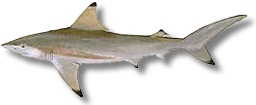 Description: The conspicuously black-tipped fins give this species its name. It is dark gray, bluish or blacktip shark dusky bronze above, white or yellowish white below.
Description: The conspicuously black-tipped fins give this species its name. It is dark gray, bluish or blacktip shark dusky bronze above, white or yellowish white below.
Where Found: Offshore and inshore. Abundant in the Gulf of Mexico. Often found in over reef, humps and ledges, or sharp drop offs where sudden changes in current are present. Usually stays in the 100ft. or less water column.
Feeding Habits: The blacktip feeds on small schooling fishes like sardines, threadfin, menhaden, mullet, and anchovies, but also eats many other including catfishes, groupers, jacks, snook, porgies, grunts, croakers, and triggerfish. They are also known to consume dogfish, sharpnose sharks, young dusky sharks, and stingrays.
Size Range: from 15-90 lbs.
Food Value: Fair table fare. Fillets/steaks are light grey and flaky when cooked. Very strong fish taste.
Cobia
 Description: Strong fish with broad depressed head; lower jaw projects past upper jaw; dark lateral stripe extends through eye to tail sometimes mistaken for a shark. When young, has a conspicuous alternating black and white horizontal stripe.
Description: Strong fish with broad depressed head; lower jaw projects past upper jaw; dark lateral stripe extends through eye to tail sometimes mistaken for a shark. When young, has a conspicuous alternating black and white horizontal stripe.
Where Found: Around wrecks, pilings, channel markers, both inshore and offshore inhabiting inlets, bays, frequently seen around buoys.
Feeding Habits: Feeds best on live bait (pinfish, cigar minnows, croakers, grunt, blue runners and squirrelfish). Also feeds on dead bait (spanish sardines, threadfin and finger mullet) squid, and crustaceans.
Size Range: From 15-70 lbs. Current Florida state record 103 lbs.
Food Value: Good table fare. Thick white fillets, with a light to mild fish taste.
Dolphin (aka Mahi-Mahi or Dorado)
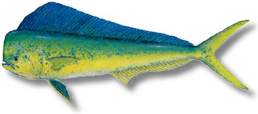 Description: Bright greenish blue with yellow on sides and a variety of other colors. Irregular blue or golden blotches scattered over sides; anterior profile of head on adult males is nearly vertical; head of females more sloping.
Description: Bright greenish blue with yellow on sides and a variety of other colors. Irregular blue or golden blotches scattered over sides; anterior profile of head on adult males is nearly vertical; head of females more sloping.
Where Found: Offshore in warm waters. Around weed lines or floating objects. One of the fastest growing fish, thought to live no more than 5 years; swimming at speeds up to 50 knots.
Feeding Habits: Feeds mostly on ballyhoo, flying fish, grass minnows, squid, and crustaceans. Trolling skirted dead bait or artificial rigs proven to be very successful method of angling. Known to change colors to all gold or yellow when feeling threatened, causing them to stop feeding.
Size Range: from 8-40lbs. Current Florida state record 77 lbs.
Food Value: Outstanding table fare. Nice white fillets, with a very light fish taste. Found on the menu at most restaurants and known as a “Florida Favorite”.
Gag Grouper
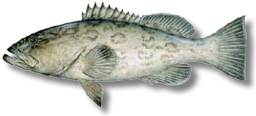 Description: Brownish gray in color with dark patch-like markings on sides.
Description: Brownish gray in color with dark patch-like markings on sides.
Where Found: Both offshore and nearshore. Larger gags usually migrate further offshore in the Summer time and move closer Inshore during the winter months.
Feeding Habits: Fees on dead bait (spanish sardines, threadfin and finger mullet) and live bait (pinfish, cigar minnows, croakers and grunts).
Size Range: From 10-60 lbs. Current Florida state record 71.3 lbs.
Food Value: Outstanding table fare. One of the most sought after eating fish in the Gulf of Mexico. Fillets are white, and flaky when cooked. Very light fish taste. Found on the menus of most Florida seafood restaurants.
Jolthead Porgy
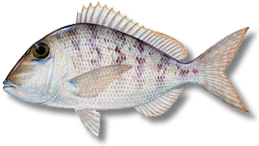 Description: Generally silvery to brassy, with a bluish cast. Front of head brown, with blue line along lower rim of eye; a whitish stripe below eye, and another between eye and mouth; corner of mouth orange.
Description: Generally silvery to brassy, with a bluish cast. Front of head brown, with blue line along lower rim of eye; a whitish stripe below eye, and another between eye and mouth; corner of mouth orange.
Where Found: Offshore in the Gulf of Mexico, around rocky reefs, debris, and wrecks, typically in 30-180 feet of water.
Feeding Habits: Feeds best on dead bait (spanish sardines, threadfin, finger mullet) squid, and crustaceans.
Size Range: from 2-10lbs. Current Florida state record n/a.
Food Value: Good table fare. White fillets, with a light to medium fish taste.
King Mackerel
(aka Kingfish)
 Description: Streamlined body with tapered head. Silver color on the side of body, with a greenish blue color on their back. A spectacular fighting fish, known for long, steady, high speed runs.
Description: Streamlined body with tapered head. Silver color on the side of body, with a greenish blue color on their back. A spectacular fighting fish, known for long, steady, high speed runs.
Where found: Offshore and nearshore, in depths from 30 feet to 200 feet. During spring and fall migrations often found nearshore.
Feeding Habits: Feeds best on live bait (blue runners, pinfish, cigar minnows, ladyfish, ribbonfish, mullet and threadfin hearing). Also feeds on dead bait (spanish sardines, threadfin and finger mullet) squid, and crustaceans.
Size Range: from 10-60lbs. Current Florida state record 90 lbs.
Food value: Good table fare if cooked properly. Fillets are grayish in color, with a medium to strong fish taste. Can be grilled, smoked, broiled or used as supplemental ingredient in fish spread.
Lane Snapper
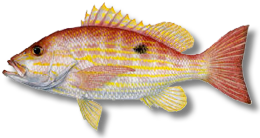 Description: Silvery-pink to reddish with short pink and yellow lines running down its side. Visible black spot near posterior of fish.
Description: Silvery-pink to reddish with short pink and yellow lines running down its side. Visible black spot near posterior of fish.
Where Found: Juveniles inshore over shallow reefs; adults offshore; most common in West Central and South Florida.
Feeding Habits: Feeds on bottom, eating crustaceans, mollusks, and fish.
Size Range: from 1-2 lbs.
Food Value: Very good table fare. White fillets, flaky when cooked with a light fish taste.
Mangrove Snapper
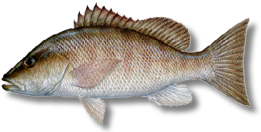 Description: Dark brown or gray with reddish or orange spots along the sides; two outstanding canine teeth at front of upper jaw; dorsal fins have reddish borders. A known to anglers as "bait stealers" and require quick reaction to successfully land.
Description: Dark brown or gray with reddish or orange spots along the sides; two outstanding canine teeth at front of upper jaw; dorsal fins have reddish borders. A known to anglers as "bait stealers" and require quick reaction to successfully land.
Where Found: Larger adults generally offshore on coral or rocky reefs. Spawns June through August
Feeding Habits: Feeds best on dead bait (spanish sardines, threadfin, finger mullet) squid, and crustaceans. Also feeds on live bait (small pinfish, or cigar minnows)
Size Range: Offshore catches common 8 to 10 pounds current Florida state record 16 lbs. 8oz.
Food Value: excellent table fare. Fillets are white and flaky when cooked. Very light fish taste.
Mutton Snapper
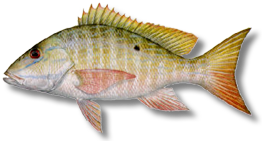 Description: Olive green on back and upper sides, all fins below the mid-section having reddish tinge; bright blue line below eye. Small black spot below dorsal fin.
Description: Olive green on back and upper sides, all fins below the mid-section having reddish tinge; bright blue line below eye. Small black spot below dorsal fin.
Where Found: Larger adults found offshore in deeper water. Hard bottom, rock piles, wrecks, potholes. Some near shore.
Feeding Habits: Feeds on small fish and crustaceans. Best caught on dead bait (spanish sardines, threadfin, finger mullet) squid, and crustaceans. Also feeds aggressively on live bait (small pinfish, or cigar minnows).
Size Range: common to 15 lbs. Current Florida state record 27 lbs., 6 oz.
Food Value: Outstanding table fare. Fillets are white and flaky when cooked. Very light fish taste with a sweet flavor. Similar in taste to red snapper.
Red Grouper
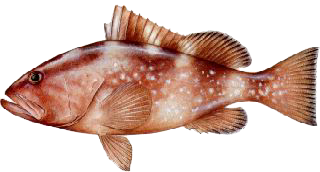 Description: Brownish red; lining of mouth scarlet-orange; blotches on sides in unorganized pattern.
Description: Brownish red; lining of mouth scarlet-orange; blotches on sides in unorganized pattern.
Where Found: Bottom dwelling fish associated with hard bottom; juveniles offshore along with adults greater than 6 years old; fish from 1 to 6 years occupy nearshore reefs.
Feeding Habits: Feeds on dead bait (spanish sardines, threadfin, finger mullet) and live bait (pinfish, cigar minnows, croakers, grunts) squid, and crustaceans
Size Range: from 10-60 lbs. Current Florida state record 71.3 lbs.
Food Value: Outstanding table fare. Fillets are white, and flaky when cooked. Very light fish taste. Found on the menus of most Florida seafood restaurants.
Red Snapper
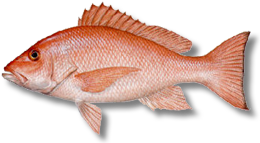 Description: Color reddish pink over entire body. Lower portion of body off-white in color. Fierce biters and fierce fighters. Offer a good strong fight from hook set to gaff.
Description: Color reddish pink over entire body. Lower portion of body off-white in color. Fierce biters and fierce fighters. Offer a good strong fight from hook set to gaff.
Where Found: Offshore in deeper water. Hard bottom, rock piles, wrecks, potholes. Some near shore.
Feeding Habits: Feeds best on dead bait (spanish sardines, threadfin and finger mullet) squid and crustaceans. Also feeds on live bait (small pinfish, or cigar minnows)
Size Range: Adults may live more than 20 years, and attain 35 pounds or more current Florida State Record 46 lbs., 8 oz
Food Value: Outstanding table fare. Fillets are white and flaky when cooked. Very light fish taste with a sweet flavor.
Sailfish
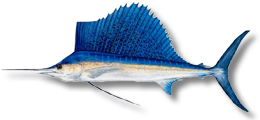 Description: Dark blue on top, brown-blue laterally, silvery white underbelly; upper jaw elongated in form of spear; first dorsal greatly enlarged in the form of a sail, with many black spots, body covered with embedded scales, blunt at end; lateral line curved above pectoral, then straight to base of tail.
Description: Dark blue on top, brown-blue laterally, silvery white underbelly; upper jaw elongated in form of spear; first dorsal greatly enlarged in the form of a sail, with many black spots, body covered with embedded scales, blunt at end; lateral line curved above pectoral, then straight to base of tail.
Where Found: Offshore species, in South Florida and Gulf of Mexico associated with waters near the gulf stream; off the panhandle near the 100-foot fathom line. Rapid growing species, reaching 4 to 5 feet in a single year; swims at speeds up to 50 knots
Feeding Habits: feeds on the surface or at mid-depths, on ballyhoo, flying fish, smaller pelagic fishes and squid. Known for their spectacular out of water aerial leaps when hooked.
Size Range: from5-7 feet, and around 40-80lbs. Current Florida state record 116 lbs.
Food Value: Poor
Scamp Grouper
 Description: Light gray or brown, reddish brown spots on sides that tend to be grouped into lines; some yellow around corners of mouth. Spawns in late spring undergoes sex transformation from female to male as it becomes older.
Description: Light gray or brown, reddish brown spots on sides that tend to be grouped into lines; some yellow around corners of mouth. Spawns in late spring undergoes sex transformation from female to male as it becomes older.
Where Found: Offshore around rocky reefs, debris, and wrecks, typically in 40-150 feet of water.
Feeding Habits: Feeds best on live bait (pinfish, cigar minnows, croakers, grunt, squirrelfish) . Also feeds on dead bait (spanish sardines, threadfin, finger mullet) squid, and crustaceans.
Size Range: from 5-15lbs. Current Florida state record 28 lbs.
Food Value: Good table fare. Flaky white fillets, with a light to medium fish taste.
Black Sea Bass
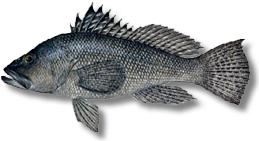 Description: Black or dark brown skin with black on white stripes. Distinguishable fatty hump no top of head.
Description: Black or dark brown skin with black on white stripes. Distinguishable fatty hump no top of head.
Where Found: Offshore found on hard bottom and rubble.
Feeding Habits: Aggressive bottom feeders. Eat small fish, shell fish, and crustaceans.
Size Range: from 1.5 to 3.5 lbs. Florida record 5.1 lbs.
Food Value: Excellent table fare. Very white, flaky meat with a light fish taste.
Spanish Mackerel
 Description: silver sides with green color on back. Golden yellow irregular spots above and below mid-section; front of dorsal fin. A great fighting fish on light to medium tackle.
Description: silver sides with green color on back. Golden yellow irregular spots above and below mid-section; front of dorsal fin. A great fighting fish on light to medium tackle.
Where Found: Inshore, nearshore and offshore - especially over grass beds and reefs; absent from North Florida waters in winter.
Feeding Habits: Feeds best on live bait (small pinfish, glass minnows, greenbacks). Also feeds well on dead bait (chunked spanish sardines, threadfin and finger mullet) squid, and crustaceans. Artificial flash spoons and jigs.
Size Range: from 2-10 lbs. Current Florida state record 12 lbs.
Food Value: Good table fare if cooked properly. Fillets are grayish in color, with a medium to strong fish taste. Can be grilled, smoked, broiled or used as supplemental ingredient in fish spread.
Grey Triggerfish
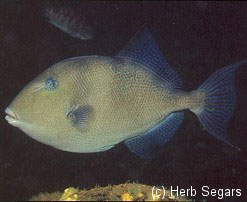 Description: The body of the gray trigger is light gray to brown. The dorsal and anal fins are marked with spots and lines. Their skin is tough in texture with an almost leather feel to it.
Description: The body of the gray trigger is light gray to brown. The dorsal and anal fins are marked with spots and lines. Their skin is tough in texture with an almost leather feel to it.
Where Found: Found in a wide range of habitats offshore and nearshore. Harbors, lagoons, rock and coral reefs ,or in the water column, especially around sargasso mats
Feeding Habits: feeds on hard bodied prey such as scallops, clams, barnacles, starfish, and dollars. Triggers are equipped with very strong jaws and teeth used to crush their prey.
Size Range: from 2-10 lbs. Current Florida state record 12 lbs.
Food Value: good table fare. Fillets white and flaky when cooked. Considered a delicacy by many.
Wahoo
 Description: A member of the mackerel family. Head is pointed sharply. Distinguishable dark blue coloring along its back. Light blue vertical "Tiger Stripes" down the side which become more visible or "light up" when fish is feeding or becomes aggressive.
Description: A member of the mackerel family. Head is pointed sharply. Distinguishable dark blue coloring along its back. Light blue vertical "Tiger Stripes" down the side which become more visible or "light up" when fish is feeding or becomes aggressive.
Where Found: Found offshore in clear warm tropical waters near the surface. Prefers water temperatures of 71-79 degrees. Often found in deeper water, over reef, humps and ledges, or sharp drop offs where sudden changes in current are present.
Feeding Habits: A high speed, aggressive feeder, and known to reach speeds in excess of 50 mph when feeding. Prefers small fish, sardines, threadfin, cigar minnows, and squid, Often hover near bottom and shoot up near surface at high speed to attack bait.
Size Range: From 15-90 lbs.
Food Value: Excellent table fare. Fillets/Steaks are white and flaky when cooked. Mild to medium fish taste. Know to have a “sweet” flavor to meat.
Key West Grunt (aka White Grunt)
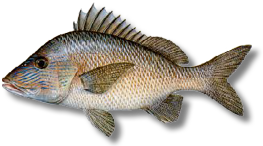 Description: Bluish-gray, head has horizontal blue stripes, white underbelly; large bright orange mouth
Description: Bluish-gray, head has horizontal blue stripes, white underbelly; large bright orange mouth
Where Found: From shore to the outer reef edge or on offshore hard bottom to 115 feet; most abundant in water less than 80 feet deep.
Feeding Habits: feeds on squid, crustaceans, mollusks and small fishes. Provides a good little fight for its size. Average catch per angler is around 15-20 fish.
Size Range: Most common catches 1-2 lbs.
Food Value: Excellent table fare. Fillets are small, but make a great meal in quantity. Best if breaded and pan-fried. Famous Florida dish “grits and grunts”.
We've had some amazing catches over the years. Check out our Photo Gallery to see what we catch on Florida's gulf coast...See More
Book your fishing trip of a lifetime now! Offshore Hustler can comfortably accommodate up to 6 passengers... Read More
Fish in style and comfort aboard a 35' Triton fully loaded with Furuno electronics and powered by triple 300 HP Yamaha four strokes..... Read More


